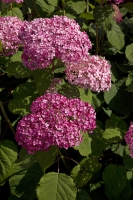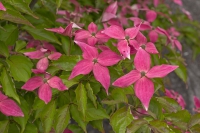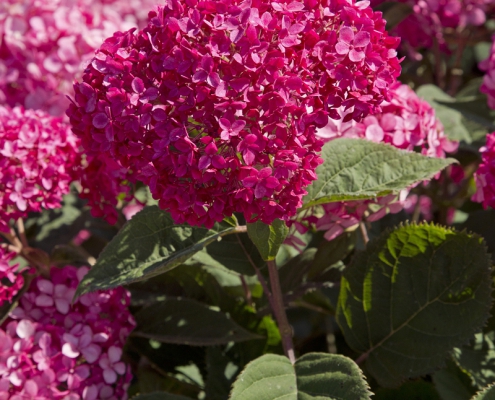During two field trials on May 27th and July 5th 3 plants were awarded with the KVBC-Award by the trialcommittee of the KVBC.
Gold
Hydrangea arborescens ‘NCHA3’ (RUBY ANNABELLE) was awarded with a golden KVBC-Award. The trialcommittee judged this cultivar as follows: ‘Low and broad plant with large inflorescences and healthy dark green leaves. The branches have an average firmness, but this contributes to the spherical habitus. The inflorescences are deep pink-red, unique within H. arborescens. Great for use in gardens of all sizes, as well as in public spaces or in pots. The combination of intense flower colors and stocky growth make ‘NCHA3’ (RUBYANNABELLE) a unique breakthrough! ‘
Go to the trial report of hydrangea arborescens ‘NCHA3’>>
Silver
Two plants have been rewarded with a silver KVBC-Award: Hydrangea arborescens ‘NCHA2’ (PINK ANNABELLE) and Cornus kousa ‘Rutpink’ (SCARLET FIRE).
 The trialcommittee about the hydrangea arborescens ‘NCHA2’: ‘Relatively high, but firm plants with very big inflorescences and medium green leaves. The branches are pretty sturdy. Great for large(er) gardens, less for small(er) gardens or in pots. There are several other pink-flowering H. arborescens, making ‘NCHA2’ not a unique breakthrough. The brand name can be somewhat misleading because the young inflorescences are deep pink-red. “NCHA2” is an improvement on “NCHA1,” which was also traded under the PINK ANNABELLE brand. “
The trialcommittee about the hydrangea arborescens ‘NCHA2’: ‘Relatively high, but firm plants with very big inflorescences and medium green leaves. The branches are pretty sturdy. Great for large(er) gardens, less for small(er) gardens or in pots. There are several other pink-flowering H. arborescens, making ‘NCHA2’ not a unique breakthrough. The brand name can be somewhat misleading because the young inflorescences are deep pink-red. “NCHA2” is an improvement on “NCHA1,” which was also traded under the PINK ANNABELLE brand. “
Go to the trial report of Hydrangea arborescens ‘NCHA2’>>
 The trial committee ruled on the award-winning Cornus kousa ‘Rutpink’:
The trial committee ruled on the award-winning Cornus kousa ‘Rutpink’:
“The only cultivar with which this plant can be compared is’Satomi’. The bracts of ‘Rutpink’ are larger, sharper and slightly deeper from pink-red. What is striking is the better form of growth, but like many other Cornus, the plants are not very uniform. According to the contributor, the leaves turn brown-red and the autumn colors are striking; this was not determined during the trial. According to specification, the plant is a cross; parents have not (yet) been released. Plants in the garden are grafted on C. kousa. The discussion indicated that Rutgers University crosses C. kousa with C. florida. ‘Rutpink’ (SCARLET FIRE) has the most characteristics of C. kousa. But to what extent this is a “pure” cultivar of C. kousa is unclear. To be sure the parents must be known. Initially, the committee reached an average of 7.0, good for a KVBC Bronze Award. ‘Satomi’ was previously awarded with Gold and the trial committee considered a reconsideration necessary. After discussion, the figure for habitus was adjusted from 7 to 8. ”



